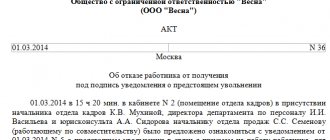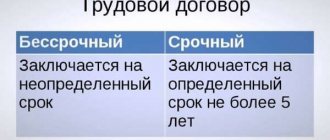Why is it worth making an agreement?
Dismissal can occur in three main forms:
- at your own request;
- “according to the article”;
- peacefully, i.e. by agreement.
All of them are encountered quite often in practice, but it is the third option that is considered the most acceptable and desirable. This is due to the fact that it has some advantages both for the employee of the enterprise and for his employer.
The positive aspects for the employee are quite obvious:
- He can leave without “working off”, or, conversely, has the opportunity to request the time he needs to look for a new job (above the usual two weeks).
- With the consent of management, he can receive decent “compensation”.
- And in the employment service, if a person who quits by agreement of the parties decides to register there, the benefit will be much larger than in other cases.
- In addition, if the employee can maintain a good relationship with the former employer, the employee is likely to receive exceptionally good letters of recommendation - and such arguments often play a fundamental role in the decision to accept a job from large company recruiters.
Advantages of dismissal by agreement for the employer:
- The likelihood that in the future the employee will withdraw his application for termination of the employment relationship is reduced to zero (which is extremely important in cases where the employee has become redundant or unwanted for some reason).
- With this form of dismissal, there is no need to listen to the opinion of the trade union cell, which, as is known, does not always coincide with the opinion of the employer.
- If for some reason the case reaches the judicial service or the labor inspectorate, the enterprise management will have evidence that everything happened according to the law (of course, if the procedure is completed in compliance with all the necessary formalities).
How to draw up an order to dismiss a conscript
The notice period depends on the conditions for termination of the contract, as well as on its duration.
| Situation | Day of delivery of notice |
| Conclusion of a contract for the period of replacement of the main employee | The day a permanent employee goes back to work |
| Conclusion of an agreement for the duration of the work (provision of services) | 3 days before the estimated completion date of these works (services) |
| Other cases | 3 days before the date of termination of the contract |
If the termination of a fixed-term contract occurs while the employee is ill, then a notice of expiration is still sent to him, and the dismissal is formalized on the specified day. A fixed-term contract is not terminated only in one case, if the fixed-term contract is pregnant.
Women in this position cannot be fired until the end of pregnancy or until the end of maternity leave, if provided, and the employer is obliged to provide such leave to a pregnant conscript. If, for health reasons, a woman cannot continue to cope with the work that she performed under a fixed-term contract, then she needs to be offered other jobs where she will be healthy enough to perform her job duties.
A fixed-term contract with a pregnant woman is terminated only if the woman herself wants it, or she is not suitable for the position she occupies, and there are no other positions in the company for her (or the woman is not satisfied with them).
We invite you to read: The moment of concluding a gift agreement - advice from lawyers and lawyers
| ★ Best-selling book “Accounting from Scratch” for dummies (understand how to do accounting in 72 hours) purchased by {amp}gt; 8000 books |
Cons of the agreement
To be fair, it should be said that terminating an employment relationship by agreement also has its downsides. In particular:
- in most cases, the employee does not have the right to withdraw his application unilaterally;
- The company's management can fire him even during a period of temporary incapacity.
Sometimes employers refuse to reach an agreement with an employee, especially if the latter has previously committed a serious offense.
Extension of a fixed-term employment contract
Upon expiration of the contract, it can be extended. This procedure takes place by agreement of both parties. It is worth noting that the employee himself may demand an extension of a fixed-term employment contract , but only in those cases provided for by the legislation of the country. For example, if the general term of the contract expires during the woman’s pregnancy, then in this case, the employer is obliged, through a written application from the employee, to extend the term of the fixed-term employment contract until the end of her pregnancy. It is worth noting that the employee will also have to provide a medical certificate that will confirm her situation. More details about this can be found in Article 261 of the Labor Code of the Russian Federation.
Another point that is worth mentioning is that a fixed-term employment contract can be transformed into an open-ended contract. So, if neither party decides to demand termination of the contract, and the employee continues to work, then the terms of the fixed-term contract cease to work and automatically transfer to an indefinite period.
↑ to contents
Procedure for dismissal by agreement
In order to dismiss an employee by agreement of the parties, it is necessary for him to write a corresponding statement.
The application must be submitted to a HR department specialist no later than fourteen days before the expected day of dismissal (permissible earlier if the parties have reached such an agreement).
After the application is accepted, the management of the enterprise issues an order, on the basis of which an agreement is written.
During the period remaining until the day of dismissal, the personnel officer is obliged to prepare all documents and supplement the entries in the personal card of the resigning person and his work book, and the accounting staff at this time must have time to accrue settlement funds.
Drawing up an agreement
There is currently no unified, standard form of agreement on termination of an employment contract, so company employees can create this document in free form, or, if the organization has a developed and approved sample, using its template. The main requirement that must be met is that the composition of the agreement meets certain rules of office work, and in relation to the text it contains a number of certain information.
The structure of the document can be divided into three parts: the header, the main section and the conclusion.
The name of the employer company, place, and date of conclusion of the agreement are entered in the “header”.
The main part of the agreement includes information about the employee:
- his position;
- FULL NAME;
- reference to the employment contract, on the issue of termination of which the parties have reached an understanding (number, date of conclusion);
- the fact of reaching an agreement is recorded;
- the date on which the employee leaves.
If there are any additional terms of the agreement, they must be included in the document.
It is necessary that the document be endorsed by the head of the organization (or a person authorized to act on his behalf) and the resigning employee.
If the regulatory legal acts of the enterprise stipulate a requirement to certify papers using seals, the form must be stamped.

Discussion of the terms of the agreement
If the employee or employer has agreed to the dismissal proposal by agreement of the parties, then the most important stage begins - discussing all the details. Such conditions should not be imposed by one party. That is, both the employee and the employer must come to a common agreement based on the results of the negotiations, since termination of the contract is interesting to both of them.
Let’s remember the situation with Ivan and “LLC” Rose. Ivan, as an employee, may be interested in early termination by agreement of the parties, as he wants to receive good compensation upon dismissal. And Rosa LLC, as an employer, is interested in “getting rid of” Ivan, who is not interested in work, and quickly finding a new employee who will be happy to complete tasks.
To avoid possible legal disputes, the employer should not pressure or force the employee to sign an agreement on its terms. Otherwise, such an agreement may be declared invalid and the dismissal may be illegal.
Discussion of terms does not always look like negotiations. Often, an employee reads a pre-prepared text of an agreement and, before signing it, makes a decision: agree completely with its terms, make any changes to it, or completely refuse the proposed conditions.
Let's consider the most important questions that may arise during the discussion stage:
- What terms are the parties discussing?
The most important thing is to reach agreement on the date of termination of the contract, since labor legislation does not establish “work periods”, as, for example, when dismissal is initiated by an employee.Since the Labor Code of the Russian Federation does not establish special compensation payments upon dismissal by agreement of the parties, the employee and the employer can also discuss the amount of such payments.
It should be noted that the parties have the right to determine any conditions of dismissal, since the law does not limit them to this (for example, an employee, before terminating a fixed-term contract, can ask the employer for leave, etc.).
- Who draws up the agreement?
As a general rule, the text of the agreement is developed either by a personnel officer (HR specialist), or a lawyer, or another representative of the employer who knows labor law.After this, the agreement is transferred to the employer and employee for review. However, the employee may insist that he also participate in developing the text of the agreement.
How to draw up a document (with a sample)?
Labor legislation does not contain a generally accepted example of an agreement, so in each specific case such a document may look different. However, in practice it is customary to compose it as follows (see example):
Agreement on termination of a fixed-term employment contract (sample)
A set of elements that are recommended to be specified when compiling this document:
- Agreement header, which includes:
- Information about the parties to the labor relationship - the full name of the employer and full name of the employee.
- The date the agreement was signed, as well as its number, which is indicated for internal recording of the employer’s documents.
- Information about the fixed-term employment contract (number and date of conclusion, you can also indicate the expiration date of the contract).
- The main part of the document, which consists of the terms of the agreement reached. As a general rule, these conditions include:
- Date of the employee’s last working day (date of termination of the fixed-term employment contract). Any date can be set, that is, the employee and the employer can decide to terminate a fixed-term employment contract either on the day the agreement is signed or several months after its signing.
- Compensation payments and additional remuneration that are due to an employee upon dismissal. The employer, in agreement with the employee, can determine any amount of such payments. To avoid disputes, it is best that the exact amount of compensation be specified in the agreement. Since the employer does not always fulfill its obligations in good faith, the employee is recommended to insist that the date of payment be clearly stated, as well as penalties for late payment.
- Other obligations on the part of the employer (for example, providing the employee with leave before terminating the contract, etc.).
- Responsibilities that an employee must fulfill before leaving (for example, putting the workplace in order, finishing a project, transferring materials to a colleague, etc.).
- The parties have no claims against each other.
- Signatures of the parties. When signing an agreement, the employee should pay attention to the authority of the person signing the document on the employer’s part.
Important! The document is drawn up in two copies.









